Arrowleaf violet, Viola sagittata, is a native herbaceous perennial plant showing in spring the characteristic violet-blue flowers of most violets. However, its distinctive lobed leaves separates it from most other species of violets. Violets are frequently found in shady areas but they are often not recognized as an important part of the eco-system.
Violets have two types of flowers: chasmogamous flowers which are the flowers we normally see and cleistogamous flowers which are not showy, remain closed, and self-fertilize. Here the discussion is about the chasmogamous flowers.
The violet family has a long history of taxonomic confusion and dispute and many hybrids have been found. Since violet species are frequently difficult to identify, the features that are used in a dichotomous key are presented here. These features are useful to help distinguish between the species. There are two varieties of Viola sagittata that will not be distinguished here. Some reports separate the varieties into 2 separate species.
Plant & Leaves
Arrowleaf violet, Viola sagittata, plants and leaves:
The first level of characterization of violet species is whether the violet plant is stemmed or stemless.
- Stemmed (caulescent,): The plant produces a stalk with both leaves and flowers. The flowers grow from the leaf axils. Also, basal leaves may or may not be present.
- Stemless (acaulescent): The plant produces separate flower stalks and leaf stalks. The leaf and the flower stalks emerge directly from the ground (rhizomes or stolons). Leaves are all basal.
Arrowleaf violet, Viola sagittata is stemless. Its distinctive lobed leaves separate it from most other species of violets. However, there are other species of violets with lobed leaves.
- plant: stemless (acaulescent), leaves & flower stalks directly from the ground/rhizomes (below ground).
- plant: about 12 inches tall
- flower stalks: upright, taller than the leaves.
- leaves: shallow round-toothed edges, sometimes with hairy edges, two types of leaves with shapes somewhat variable.
- early leaves: smaller, rounder, shorter petioles (leaf stalks), more horizontal, none to few small lobes near the base.
- primary (later leaves): longer, about 3.5 inches, longer petioles, more erect, somewhat arrow shaped, pronounced lobes but confined to the lower half of the leaf.
The plant produces separate flower stalks and leaf stalks. The leaf and the flower stalks emerge directly from the ground. Leaves are all basal. The red arrows point to leaves produced earlier in the season.

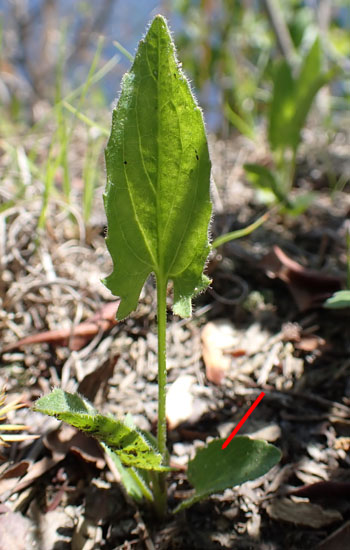
Early leaves (red arrows on photos above, at base of plant). Early leaves may have no lobes or small lobes at the base of the leaf.
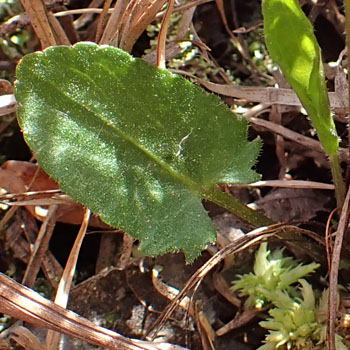
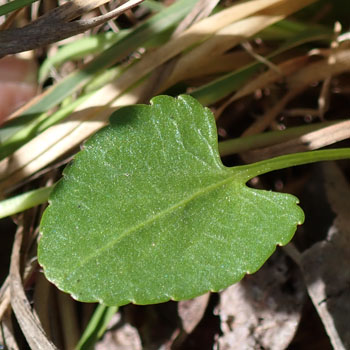
Primary - later leaves (taller leaves in top photos above). Later leaves (photos below) have distinct lobes in the lower half of the leaf. There is some variability in the lobes but they are always in the lower half of the leaf.

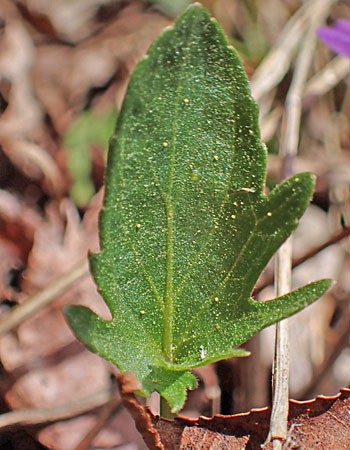
Flowers & Fruit
Arrowleaf violet, Viola sagittata, flower & fruit:
Several flower stalks can arise from the ground, each with a single flower at the top. The stalks curve downward at the top so the flower is slightly nodding. The flower has the characteristic blue-violet corolla with 5 petals - 2 upper, 2 lateral, and 1 lower lip. Also, it has 5 stamens and 1 pistil and 5 sepals.
General violet flower structure
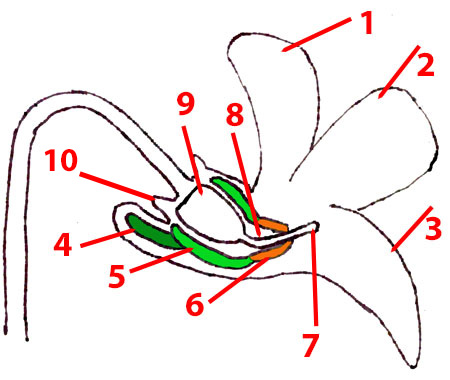
- upper petal
- lateral petal
- lower lip, back extends into a spur
- nectary structure: the lower two anthers have spur-like nectary glands on their back side and they extend into the spur of the lower petal
- anthers form a ring around the ovary
- anther appendage, brown/orange color, encircles the style; together with the anthers, a cone is formed around the ovary and part of the style; the anthers release the pollen into the interior of the cone.
- stigma, shape depends on species
- style
- ovary
- sepal with auriculate appendage at base
Key flower characteristics of Arrowleaf violet, Viola sagittata:
- flowers: relatively larger, about 3/4 inches across.
- petals: blue-purple with white at the base
- lateral petals: bearded with tuffs of fine hairs at the base
- lower petal: prominent dark purple veins from the center; slightly hairy; extended from the back is a short nectar spur
- stigma: expanded, not bearded, capitate with conical beak on the lower side. See close up photo below.
- sepal with auricles generally prominent and entire, elongating to 3 mm when fruiting
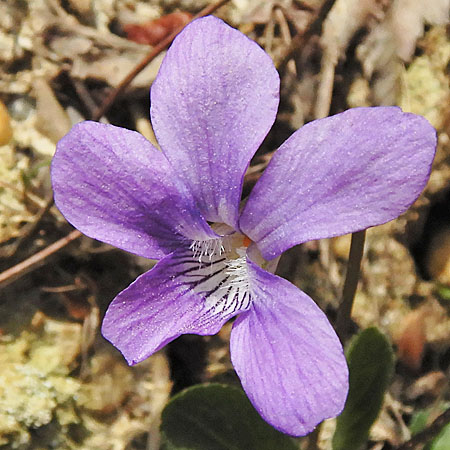
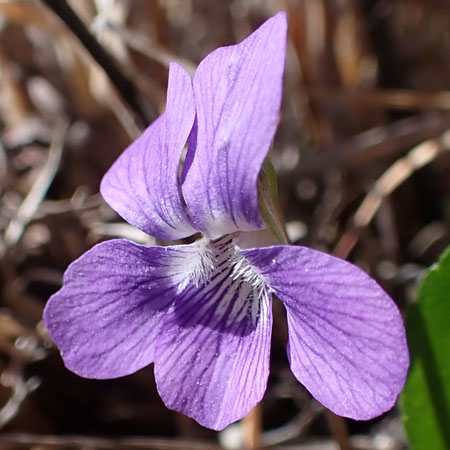
The stigma has a projection toward the lower petal/lip. The brown/orange part is the anther appendage that surrounds the ovary and part of the style. For photos of dissected violet flowers, see our yellow violet page

The small spur which is an extension of the lower lip contains nectar. Sepals have small 'auricle/ ear-like' tabs.

Developing fruit shows clearly the sepals and the large auricle appendages (red arrows).

Fruit has split open into 3 parts and release all its seeds.
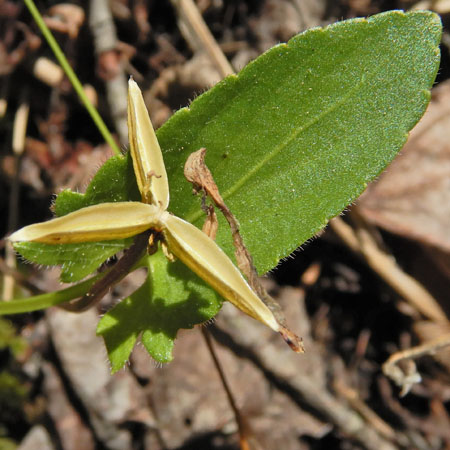
Arrowleaf violet grows in part shade and moist soil although it also grows in various habitats.
Arrowleaf violet is quite common and blooms late April to early May.
Violets are an important part of the eco-system: the flower provides pollen & nectar for early insects. Violets are the host plants for fritillary butterfly species - adults lay their eggs next to or on the violets and when the caterpillars emerge, they feed on the violet leaves. Birds eat the seeds and leaves and stems are eaten by some mammals. Fortunately, deer do not prefer violets for food.
Text & diagram by Millie Ling and all photos by Hubert & Millie Ling. Photos: flowers April 25, 2025, fruit May 19, 2025; Plainsboro Preserve, NJ.
Additional information / References
Additional information / references:
- Illinois Wildflowers: descriptions https://www.illinoiswildflowers.info/prairie/plantx/arrow_violet.html
- Minnesota wildflower: descriptions https://www.minnesotawildflowers.info/flower/arrow-leaved-violet
- GoBotany: Viola sagittata — arrowhead violet https://gobotany.nativeplanttrust.org/species/viola/sagittata/
- Flora of North America: descriptions http://www.efloras.org/florataxon.aspx?flora_id=1&taxon_id=242417475
-
Key to violets: New England has all the species of violets of NJ except it is missing one species that is stemless.
Go Botany Dichotomous Key to Viola https://gobotany.nativeplanttrust.org/dkey/viola - Flora of North America, Dichotomous Key to the Violets: http://www.efloras.org/florataxon.aspx?flora_id=1&taxon_id=134607